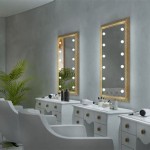How To Hang A Heavy Mirror On Drywall With Studs
Hanging a heavy mirror can significantly enhance a room's aesthetic, adding light, depth, and a touch of elegance. However, neglecting proper installation techniques can lead to disastrous results, including damaged walls, a shattered mirror, and potential injury. This article provides a comprehensive guide on securely hanging a heavy mirror on drywall, utilizing the structural support of wall studs. Emphasis is placed on safety, accuracy, and the selection of appropriate hardware.
Before commencing, it is crucial to assess the mirror's weight and dimensions. This information is typically found on the packaging or can be obtained from the manufacturer. Knowing the weight is paramount for selecting suitable mounting hardware and ensuring the structural integrity of the installation. Furthermore, evaluating the mirror's size helps determine the optimal placement on the wall and the number of studs required for support.
The next step involves gathering the necessary tools and materials. A stud finder, measuring tape, pencil, level, drill, drill bits (sized appropriately for pilot holes and screws), screwdriver, wall anchors (if necessary), heavy-duty picture hanging hooks or D-rings (pre-attached to the mirror or purchased separately), and appropriate screws are essential. Safety glasses are recommended to protect the eyes from debris during drilling. A step ladder may also be necessary to reach the desired hanging height.
Identifying Wall Studs and Marking Their Location
Accurate identification of wall studs is the cornerstone of a secure mirror installation. Wall studs are vertical framing members that provide structural support in a wall. They are typically spaced 16 or 24 inches apart, center to center. Several methods can be employed to locate studs, ranging from simple techniques to sophisticated electronic devices.
The most reliable method involves using an electronic stud finder. These devices detect changes in density within the wall, indicating the presence of a stud. Follow the manufacturer's instructions for proper operation. A common practice is to calibrate the stud finder on an area of the wall known to be free of studs before scanning for studs. Once a stud is located, mark its edges with a pencil. It is advisable to scan the area multiple times to confirm the stud's location and ensure accuracy.
If an electronic stud finder is unavailable, alternative methods can be used, although they may be less precise. One method involves tapping lightly on the wall. A solid sound generally indicates the presence of a stud, whereas a hollow sound suggests an empty cavity. Another approach is to look for nail holes or screw depressions, which are often used to attach drywall to the studs. Measuring 16 or 24 inches from a known stud location (such as a corner or doorway) can also provide an approximate stud location.
After identifying potential stud locations, it is prudent to verify their position by driving a small nail or screw into the wall where the marks are. If the fastener encounters solid wood, a stud has been located. If the fastener passes easily through the drywall, it has missed the stud. This method should be performed carefully to avoid causing unnecessary damage to the wall.
Once the studs are located and verified, measure and mark the desired hanging position for the mirror on the wall. Use a level to ensure the marks are horizontally aligned. If possible, aim to position the mirror so that its hanging hardware aligns with two studs for maximum support. If the mirror's hanging hardware is not adjustable, precise measurements are essential.
Preparing the Wall and Attaching the Mounting Hardware
With the stud locations identified and the desired hanging position marked, the next step involves preparing the wall and attaching the mounting hardware. This process requires careful attention to detail to ensure a secure and aesthetically pleasing installation.
If the mirror has integrated hanging hardware, such as D-rings or wire, ensure they are securely attached and appropriately positioned. For mirrors without pre-installed hardware, heavy-duty picture hanging hooks or D-rings should be attached to the back of the mirror frame. Use screws that are of appropriate length and gauge to securely fasten the hardware without penetrating the front of the mirror frame. Applying felt pads to the back corners of the mirror frame can help prevent scratches on the wall and provide a more even surface for hanging.
Using the previously marked stud locations, pre-drill pilot holes into the studs at the desired hanging height. The pilot holes should be slightly smaller than the screws that will be used to attach the mounting hardware. Pre-drilling prevents the wood from splitting and makes it easier to drive the screws in straight. Ensure the pilot holes are drilled deep enough to accommodate the full length of the screws.
Select appropriate screws for attaching the mounting hardware to the studs. Drywall screws are generally not suitable for this purpose, as they are brittle and prone to snapping under heavy loads. Instead, use wood screws or construction screws that are specifically designed for wood-to-wood connections. The length of the screws should be sufficient to penetrate at least 1 inch into the stud.
Align the mounting hardware (heavy-duty picture hanging hooks or D-rings) with the pre-drilled pilot holes and drive the screws into the studs. Use a screwdriver to tighten the screws firmly, but avoid over-tightening, which can strip the screw heads or damage the wall. Ensure the mounting hardware is securely attached and can support the weight of the mirror. If the mirror's hanging hardware doesn't exactly align with the studs, consider using horizontal mounting bars screwed into two studs with multiple points from which to hang the mirror.
If the mirror is too wide to span two studs or if the hanging hardware does not align with the studs, wall anchors may be necessary to provide additional support. However, wall anchors should be used sparingly and only in conjunction with stud support whenever possible. Select wall anchors that are rated to support the weight of the mirror. Toggle bolts or heavy-duty expanding anchors are recommended for heavy mirrors. Follow the manufacturer's instructions for installing the wall anchors. Remember that anchors in drywall alone cannot support as much weight as a screw directly into a stud. Use anchoring as a supplement, not a replacement, for stud attachment.
Hanging the Mirror and Ensuring Stability
Once the mounting hardware is securely attached to the wall, the final step involves carefully hanging the mirror and ensuring its stability. This requires patience and attention to detail to prevent accidental damage or injury.
Carefully lift the mirror and align its hanging hardware with the mounting hardware on the wall. Slowly lower the mirror onto the hooks or D-rings, ensuring that it is securely supported. If using wire, ensure that the wire is properly seated on the hooks and that there is enough slack to prevent undue stress on the wire. It's often advantageous to have a second person assist with lifting and positioning the mirror, particularly if it is large or heavy.
After the mirror is hung, use a level to check its horizontal alignment. If necessary, gently adjust the position of the mirror until it is perfectly level. Small adjustments can be made by slightly shifting the mirror on the hooks or by adding shims behind the mirror frame.
To further ensure the stability of the mirror, consider using adhesive bumpers or felt pads along the bottom edge of the mirror frame. These bumpers will prevent the mirror from shifting or swinging and will also protect the wall from scratches. Additionally, they can help to distribute the weight of the mirror more evenly, reducing stress on the mounting hardware.
Finally, perform a thorough inspection of the installation. Check that all screws are securely tightened and that the mounting hardware is firmly attached to the wall. Give the mirror a gentle push to ensure that it is stable and does not wobble or sway. If any issues are detected, address them immediately to prevent potential problems in the future.
Proper planning, careful execution, and the use of appropriate hardware are essential for successfully hanging a heavy mirror on drywall with studs. By following the steps outlined in this guide, one can confidently enhance the beauty of the room while ensuring the safety and security of the installation.

How To Hang A Heavy Mirror Or Picture Right The First Time

How To Hang A Heavy Mirror

How To Hang A Heavy Mirror Or Picture On Wall Today S Homeowner

A Better Way To Hang Heavy Mirror

How To Hang A Heavy Mirror On Drywall Stas Picture Hanging Systems

How To Hang A Heavy Mirror With Pictures Wikihow

How To Hang A Large Or Heavy Mirror

How To Hang A Heavy Mirror

How To Hang A Mirror With Wire Pictures Wikihow

Hanging Heavy Mirror On Plaster Walls 6 Steps With Pictures Instructables








